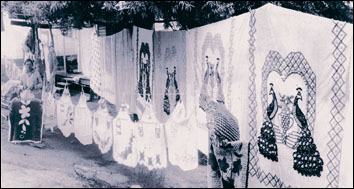|
history
of carpet tufting
 Carpet
construction began in 1895, when Catherine Evans
was inspired by a family heirloom and made her first
hand-tufted bedspread. Five years later she sold a similar
spread for $2.50. (We say carpet construction began then,
due to the early tufting and dyeing skills of Ms. Evans, which were later used
for carpet.) Carpet
construction began in 1895, when Catherine Evans
was inspired by a family heirloom and made her first
hand-tufted bedspread. Five years later she sold a similar
spread for $2.50. (We say carpet construction began then,
due to the early tufting and dyeing skills of Ms. Evans, which were later used
for carpet.)
Miss Evans moved to
Dalton from a rural community in Whitfield County.
Popularity of the bedspread grew, and when she began
receiving orders for her work, Miss Evans asked some of
her neighbors to help her.
Using quilting designs,
she showed her helpers how to stamp the pattern on the
fabric and make the tufting stitches. From this beginning,
Evans Manufacturing Company was established in 1917, and
was operated by the founder until 1963 when the business
was sold.
Early bedspread
operations were conducted in people's homes. The
"company" furnished the stamped sheeting and
yarn for tufting to the women and children who did the
work. Tufting is simply sewing yarn into the base fabric which, when
laundered, shrinks around the base of the tuft causing it to
"bloom" and stay in place.
By the late 20's and
early 30's, the carpet construction mechanization took the craft from the
homes to factories, and the tufted textile industry was
successfully on its way.
The first tufting machine
was a Singer 31-15, normally used for sewing heavy
textiles, such as tents and work clothes, but converted
especially for tufting.
About 1940, wide tufting
machines were built. Forerunners of today's giant carpet
tufting machines, the early counterparts were used to turn
out continuous rolls of tufted fabric or cotton rugs.
Dozens of people claim credit for developing the first
practical machine, and patents were issued to various
inventors, but it is impossible to name any one inventor.
Until 1954 only cotton
was used for tufting carpet. Rayon, wool, nylon and
acrylics followed and became the fibers of the modern age
of carpet, but the weaving process made it expensive and
slow to produce.
With the advent of
man-made fibers and the huge multi-needle tufting machine,
there have been dramatic changes in the carpet industry. A
wide range of styles, patterns and colors is available at
prices affordable in most budgets. Over 500 million yards of
carpeting are tufted every year, and 65% of that is tufted
in the Dalton, Georgia area.
The
Carpet Industry
The first 12-foot-wide
tufted carpet was manufactured in the early 1950s. During
the remainder of the decade, improvements to the tufting
machines and the end product continued. Foremost among the
inventions in this decade were pattern attachment devices.
These devices permitted machines to produce multiple pile
heights and geometric and other patterns in the same piece
of carpet, something that previously was possible only in
woven carpet. With these more intricate patterns and
increasingly closer gauges, tufted carpets began to
compete successfully against woven carpets. By 1965 more
than 85 percent of broadloom carpeting sold in the United
States was tufted. Today, with minor modifications, loop
and cut-pile carpets can be manufactured on the same
machine, and pattern attachments are computerized. Efforts
continue to duplicate completely the density and pattern
of woven carpet.
© 2008 FloorBiz, Inc. All Rights Reserved
See Also:
benefits
|
decorating
|
room advisor
|
custom color
Flooring |
Flooring Guide |
Flooring Info |
Flooring Forum
| |




 Carpet
construction began in 1895, when Catherine Evans
was inspired by a family heirloom and made her first
hand-tufted bedspread. Five years later she sold a similar
spread for $2.50. (We say carpet construction began then,
due to the early tufting and dyeing skills of Ms. Evans, which were later used
for carpet.)
Carpet
construction began in 1895, when Catherine Evans
was inspired by a family heirloom and made her first
hand-tufted bedspread. Five years later she sold a similar
spread for $2.50. (We say carpet construction began then,
due to the early tufting and dyeing skills of Ms. Evans, which were later used
for carpet.)